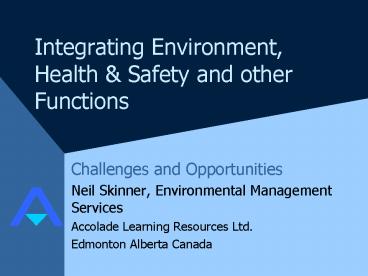Integrating Environment, Health - PowerPoint PPT Presentation
Title:
Integrating Environment, Health
Description:
Accolade Learning Resources Ltd. Edmonton Alberta Canada. The Three Major Challenges ... Linkages between EH&S goals and core business objectives are mandatory ... – PowerPoint PPT presentation
Number of Views:21
Avg rating:3.0/5.0
Title: Integrating Environment, Health
1
Integrating Environment, Health Safety and
other Functions
- Challenges and Opportunities
- Neil Skinner, Environmental Management Services
- Accolade Learning Resources Ltd.
- Edmonton Alberta Canada
2
The Three Major Challenges
- 1. Identifying clear corporate goals
- 2. Choosing the correct standards and models, and
creating an integrated composite model - 3. Establishing strong lines of communication and
effective mechanisms for decision-making
3
1. Identifying Clear Corporate Goals
- Neither environmental or OHS problems are well
served with solely reactive processes - Linkages between EHS goals and core business
objectives are mandatory - Strengthening core business objectives with sound
EHS policy should be the focus
4
2. Choosing Standards
- There are both integrated and individual
standards suitable for EHS program development - Industry models are important for substantive
foundations - Recognized international standards are crucial
for external recognition - The ultimate system should combine these 2 with
organizational needs
5
Standards in Oil Gas
- The API Model EHS is a good starting point, so
are the CAPP programs - ISO 14001 should be used as one of the underlying
models - BS 8800 is the most suitable recognized OHS
system standard - ISO 9000 can also be helpful
- All of these share many common elements
6
Integrating Different Standards
- The key to integration is to find the
commonalties among and between the standards - Re-organizing the various standards into a
workable whole is the key - Administrative and management elements share many
common characteristics - Substantive elements can simply be grouped into
functional divisions
7
3. Communication and Authority
- The third challenge is perhaps the source of the
crucial difference between effective and
superficial systems - Top-down communications are just as important as
bottom-up reporting - Employee buy-in will not be accomplished without
delegation of responsibility - Continual improvement demands this
8
Authority and Responsibility
- Adherence to procedures is not enough
- Real responsibility must be granted for effective
management - Action plans require participation throughout the
organization - Simple ideas are more likely to be implemented
9
Steps in System Development
- 1. Approve goals and objectives
- 2. Grant authority and establish clear reporting
structures - 3. Use existing best practices as a starting
point - 4. Develop both top AND bottom features first
high level system functions AND strengthened
existing operating procedures
10
Let us Help You
- We have proven ideas to help put these concepts
into practice - We do not believe that outside structures should
impede internal processes - We focus our efforts on capacity-building, not
the traditional consulting model































